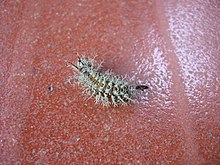Lonomia: Difference between revisions
m {{LD50}} |
|||
| Line 34: | Line 34: | ||
To date, no one has calculated the {{LD50}} values of ''Lonomia'' venom; the rate of human fatality has been documented as 1.7%, compared to a rate for [[rattlesnake]]s at about 1.8%, despite the amount of venom being only a minute fraction (less than 0.001) of that in a snake bite. Accordingly, it seems likely that when measured, the LD<sub>50</sub> for ''Lonomia'' venom will be among the lowest for any natural [[toxin]] known. As the plants the larvae feed upon are not unusually toxic, they presumably synthesize the toxin directly, but the biochemical pathways used have apparently not yet been documented. |
To date, no one has calculated the {{LD50}} values of ''Lonomia'' venom; the rate of human fatality has been documented as 1.7%, compared to a rate for [[rattlesnake]]s at about 1.8%, despite the amount of venom being only a minute fraction (less than 0.001) of that in a snake bite. Accordingly, it seems likely that when measured, the LD<sub>50</sub> for ''Lonomia'' venom will be among the lowest for any natural [[toxin]] known. As the plants the larvae feed upon are not unusually toxic, they presumably synthesize the toxin directly, but the biochemical pathways used have apparently not yet been documented. |
||
While there are more than a dozen species in the genus, the most troublesome species is ''[[Lonomia obliqua]]'', and it is this species which most of the medical research has centered |
While there are more than a dozen species in the genus, the most troublesome species is ''[[Lonomia obliqua]]'', and it is this species on which most of the medical research has centered. As anticoagulants have some very beneficial applications (e.g., prevention of life-threatening blood clots), a fair bit of the research is with the intent of deriving some pharmaceutically valuable chemicals. |
||
==References== |
==References== |
||
Revision as of 18:49, 5 December 2010
| Lonomia | |
|---|---|

| |
| Caterpillar of Lonomia obliqua | |
| Scientific classification | |
| Kingdom: | |
| Phylum: | |
| Class: | |
| Order: | |
| Family: | |
| Subfamily: | |
| Genus: | Lonomia Walker, 1855
|
| Species | |
|
Lonomia frankae | |
| Diversity | |
| 14 species | |
The genus Lonomia is a moderate-sized group of fairly cryptic saturniid moths from South America, famous not for the adults, but for their highly venomous caterpillars, which are responsible for a few deaths each year (e.g., [1]), especially in southern Brazil, and the subject of hundreds of published medical studies.
Description
The caterpillars are themselves extremely cryptic, blending in against the bark of trees, where the larvae commonly aggregate. The larvae, like most hemileucines, are covered with urticating hairs, but these caterpillars possess a uniquely potent anticoagulant venom.
Toxicity
A typical envenomation incident involves a person unknowingly leaning against, placing their hand on, or rubbing their arm against a group of these caterpillars that are gathered on the trunk of a tree. The effects of a dose from multiple caterpillars can be dramatic and severe, including massive internal hemorrhaging, renal failure, and hemolysis. The resulting medical syndrome is sometimes called Lonomiasis.
To date, no one has calculated the LD50 values of Lonomia venom; the rate of human fatality has been documented as 1.7%, compared to a rate for rattlesnakes at about 1.8%, despite the amount of venom being only a minute fraction (less than 0.001) of that in a snake bite. Accordingly, it seems likely that when measured, the LD50 for Lonomia venom will be among the lowest for any natural toxin known. As the plants the larvae feed upon are not unusually toxic, they presumably synthesize the toxin directly, but the biochemical pathways used have apparently not yet been documented.
While there are more than a dozen species in the genus, the most troublesome species is Lonomia obliqua, and it is this species on which most of the medical research has centered. As anticoagulants have some very beneficial applications (e.g., prevention of life-threatening blood clots), a fair bit of the research is with the intent of deriving some pharmaceutically valuable chemicals.
References
- Arocha-Pinango C.L., Guerrero B. (2001) Lonomia genus caterpillar envenomation: clinical and biological aspects. Haemostasis 31(3-6):288-93.
- Gamborgi G.P., Metcalf E.B., Barros E.J. (2006) Acute renal failure provoked by toxin from caterpillars of the species Lonomia obliqua. Toxicon 47(1):68-74.
- Pinto A.F., Silva K.R., Guimaraes J.A. (2006) Proteases from Lonomia obliqua venomous secretions: comparison of procoagulant, fibrin(ogen)olytic and amidolytic activities. Toxicon 47(1):113-21.
- Veiga A.B., Ribeiro J.M., Guimaraes J.A., Francischetti I.M. (2005) A catalog for the transcripts from the venomous structures of the caterpillar Lonomia obliqua: identification of the proteins potentially involved in the coagulation disorder and hemorrhagic syndrome. Gene 355:11-27.
External links
- Saturniidae World: Pictures of all species
